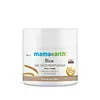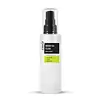What's inside
What's inside
 Key Ingredients
Key Ingredients

 Benefits
Benefits

 Concerns
Concerns

 Ingredients Side-by-side
Ingredients Side-by-side

Water
Skin ConditioningButylene Glycol
HumectantOryza Sativa Extract
AbsorbentGlycerin
HumectantMaris Aqua
HumectantGlycine Soja Seed Extract
Skin ConditioningGlycine Soja Extract
Skin ConditioningPotassium Sorbate
PreservativeCitric Acid
BufferingHydrogenated Polyisobutene
EmollientNeopentyl Glycol Diheptanoate
EmollientNiacinamide
SmoothingHydroxyethyl Urea
HumectantAmmonium Acryloyldimethyltaurate Crosspolymer
Emulsion StabilisingSodium Hydroxide
BufferingN-Vinyl Pyrrolidone
Phenoxyethanol
PreservativeEthylhexylglycerin
Skin ConditioningGlyceryl Glucoside
HumectantSaccharide Isomerate
HumectantSodium Citrate
BufferingAloe Barbadensis Leaf
MaskingPolyacrylamide
C13-14 Isoparaffin
EmollientLaureth-7
EmulsifyingSilica
AbrasiveAphanothece Sacrum Polysaccharide
AbsorbentDisodium EDTA
Sodium Hyaluronate
HumectantWater, Butylene Glycol, Oryza Sativa Extract, Glycerin, Maris Aqua, Glycine Soja Seed Extract, Glycine Soja Extract, Potassium Sorbate, Citric Acid, Hydrogenated Polyisobutene, Neopentyl Glycol Diheptanoate, Niacinamide, Hydroxyethyl Urea, Ammonium Acryloyldimethyltaurate Crosspolymer, Sodium Hydroxide, N-Vinyl Pyrrolidone, Phenoxyethanol, Ethylhexylglycerin, Glyceryl Glucoside, Saccharide Isomerate, Sodium Citrate, Aloe Barbadensis Leaf, Polyacrylamide, C13-14 Isoparaffin, Laureth-7, Silica, Aphanothece Sacrum Polysaccharide, Disodium EDTA, Sodium Hyaluronate
Water
Skin ConditioningButylene Glycol
HumectantCaprylic/Capric Triglyceride
MaskingHelianthus Annuus Seed Oil
EmollientParaffinum Liquidum
EmollientCetyl Ethylhexanoate
EmollientSodium Hyaluronate
HumectantArachidyl Alcohol
EmollientBehenyl Alcohol
EmollientArachidyl Glucoside
EmulsifyingCyclomethicone
EmollientAloe Barbadensis Leaf Extract
EmollientGlyceryl Stearate
EmollientPEG-100 Stearate
Sorbitan Stearate
EmulsifyingPolysorbate 60
EmulsifyingDiisostearyl Malate
EmollientDimethicone
EmollientHydrogenated Lecithin
EmulsifyingAllantoin
Skin ConditioningTriethanolamine
BufferingXanthan Gum
EmulsifyingTocopheryl Acetate
AntioxidantCamellia Sinensis Leaf Extract
AntimicrobialPanax Ginseng Root Extract
EmollientHoney
HumectantRosa Multiflora Fruit Extract
MaskingGardenia Florida Fruit Extract
Skin ConditioningScutellaria Baicalensis Root Extract
AstringentLigustrum Japonicum Fruit Extract
Skin ConditioningAcanthopanax Senticosus Root Extract
Skin ConditioningPunica Granatum Fruit Extract
AntioxidantCarthamus Tinctorius Flower Extract
Skin ConditioningCarbomer
Emulsion StabilisingDisodium EDTA
Leontopodium Alpinum Extract
Skin ConditioningThymus Vulgaris Extract
PerfumingMalva Sylvestris Flower Extract
Skin ConditioningBambusa Vulgaris Leaf/Stem Extract
HumectantSnail Secretion Filtrate
Skin ConditioningPhenoxyethanol
PreservativeEthylhexylglycerin
Skin ConditioningParfum
MaskingWater, Butylene Glycol, Caprylic/Capric Triglyceride, Helianthus Annuus Seed Oil, Paraffinum Liquidum, Cetyl Ethylhexanoate, Sodium Hyaluronate, Arachidyl Alcohol, Behenyl Alcohol, Arachidyl Glucoside, Cyclomethicone, Aloe Barbadensis Leaf Extract, Glyceryl Stearate, PEG-100 Stearate, Sorbitan Stearate, Polysorbate 60, Diisostearyl Malate, Dimethicone, Hydrogenated Lecithin, Allantoin, Triethanolamine, Xanthan Gum, Tocopheryl Acetate, Camellia Sinensis Leaf Extract, Panax Ginseng Root Extract, Honey, Rosa Multiflora Fruit Extract, Gardenia Florida Fruit Extract, Scutellaria Baicalensis Root Extract, Ligustrum Japonicum Fruit Extract, Acanthopanax Senticosus Root Extract, Punica Granatum Fruit Extract, Carthamus Tinctorius Flower Extract, Carbomer, Disodium EDTA, Leontopodium Alpinum Extract, Thymus Vulgaris Extract, Malva Sylvestris Flower Extract, Bambusa Vulgaris Leaf/Stem Extract, Snail Secretion Filtrate, Phenoxyethanol, Ethylhexylglycerin, Parfum
Ingredients Explained
These ingredients are found in both products.
Ingredients higher up in an ingredient list are typically present in a larger amount.
Butylene Glycol (or BG) is used within cosmetic products for a few different reasons:
Overall, Butylene Glycol is a safe and well-rounded ingredient that works well with other ingredients.
Though this ingredient works well with most skin types, some people with sensitive skin may experience a reaction such as allergic rashes, closed comedones, or itchiness.
Learn more about Butylene GlycolDisodium EDTA plays a role in making products more stable by aiding other preservatives.
It is a chelating agent, meaning it neutralizes metal ions that may be found in a product.
Disodium EDTA is a salt of edetic acid and is found to be safe in cosmetic ingredients.
Learn more about Disodium EDTAEthylhexylglycerin (we can't pronounce this either) is commonly used as a preservative and skin softener. It is derived from glyceryl.
You might see Ethylhexylglycerin often paired with other preservatives such as phenoxyethanol. Ethylhexylglycerin has been found to increase the effectiveness of these other preservatives.
Phenoxyethanol is a preservative that has germicide, antimicrobial, and aromatic properties. Studies show that phenoxyethanol can prevent microbial growth. By itself, it has a scent that is similar to that of a rose.
It's often used in formulations along with Caprylyl Glycol to preserve the shelf life of products.
Sodium Hyaluronate is hyaluronic acid's salt form. It is commonly derived from the sodium salt of hyaluronic acid.
Like hyaluronic acid, it is great at holding water and acts as a humectant. This makes it a great skin hydrating ingredient.
Sodium Hyaluronate is naturally occurring in our bodies and is mostly found in eye fluid and joints.
These are some other common types of Hyaluronic Acid:
Learn more about Sodium HyaluronateWater. It's the most common cosmetic ingredient of all. You'll usually see it at the top of ingredient lists, meaning that it makes up the largest part of the product.
So why is it so popular? Water most often acts as a solvent - this means that it helps dissolve other ingredients into the formulation.
You'll also recognize water as that liquid we all need to stay alive. If you see this, drink a glass of water. Stay hydrated!
Learn more about Water